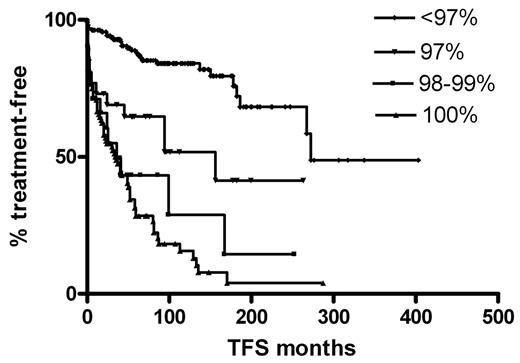Abstract
Although the distinction between chronic lymphocytic leukemia (CLL) with mutated and unmutated immunoglobulin variable region heavy chain (IgVH) genes is well established, the choice of 98% sequence homology as the limit of the unmutated subset was arbitrary, based on possible polymorphisms producing that degree of variation. Some authors chose 97% or even 95% homology as a more appropriate cut-off. We have previously shown that polymorphisms are not responsible for the sequence variation of patients with between 96.6% and 99.6% homology. Patients with small numbers of somatic mutations comprise a small proportion of the whole and in an elderly population there are many deaths unrelated to CLL. To explore the threshold requires a large series of patients and certainty about the cause of death. We have studied 310 patients seen by us either as local (260) or second opinion (50) referrals. 99 had 100% sequence homology with germ line genes, 22 between 98 and 99.9%, 22 between 97 and 97.9%, 24 between 96 and 96.9%, and 143 <96%. There have been 139 deaths of which 79 were determined to be unrelated to CLL. The median survivals, censored for unrelated deaths, were 102 months for patients with 100% homology; 132 months for those with 98-99.9%, 184 months for those with 97–97.9% and not yet reached for those with 96% or <96%. The difference between 100% and 97–97.9% was statistically significant (p=0.002) as was the difference between 97–97.9% and <97% (p<0.0001). However, the differences between 100% and 98–99.9% and between 98–99.9% and 97–97.9% did not reach statistical significance. The survival curves for those with 96–96.9% homology and <96% were virtually identical. Using treatment-free survival as an alternative end-point gave very similar results. Median times to treatment were 35 months for 100% homology, 36 months for 98–99.9%, 156 months for 97–97.9%, and 272 months for <97%. The difference between 100% and 97–97.9% was statistically significant (p=0.0014) as was the difference between 97–97.9% and <97% (p=0.0003), but the differences between 100% and 98–99.9%, between 98–99.9% and 97–97.9%, and between 96–96.9% and <96% were not.
The pattern revealed is not a continuous gradation with survival increasing with increasing numbers of mutations. Those with 97% homology comprise a mixture of benign and malignant cases rather than a homogeneous group with moderate malignancy. Most of the cases have had CD38 expression measured. Patients with 97% homology were significantly less likely to be CD38 positive than those with 100% homology (28.6% v 75.6%; p=0.0037) and significantly more likely to be CD38 positive than those with <97% homology (28.6% v 20.5%; p=0.0001). One explanation for these findings is that it is passage through the germinal center rather than the acquisition of somatic mutations per se that quells the activity of the CLL cell. It is known that small numbers of somatic mutations may be acquired in individuals who are unable to form germinal centers (eg with CD40 ligand deficiency) and it has been suggested that the small numbers of mutations sometimes found in the more aggressive form of CLL may be acquired in a similar extra-germinal center manner.
Author notes
Corresponding author


This feature is available to Subscribers Only
Sign In or Create an Account Close Modal